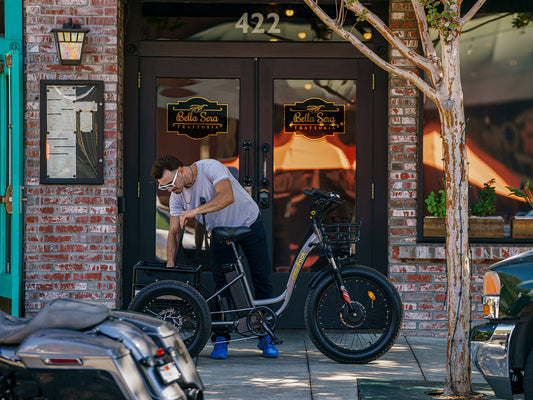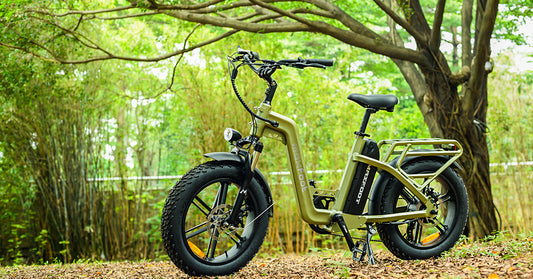Bought an e-bike? Ready for your first ride on public roads? Wait, we have something for you. Before setting off on an exciting journey, get yourself aware of biking rules and regulations.
This comprehensive guide is designed to help you in this regard. From laws and regulations to road biking essentials and road safety guidelines – we will walk you through the steps to make your e-biking experience safe and enjoyable.

Legal Framework and Regulations
In the US, e-bikes are defined as pedal-assisted vehicles with a maximum motor power of 750W and a top speed of 20mph.
Ebike Classes
In law, e-bikes are categorized into three classes:
Class 1: These are pedal-assist only, with no throttle, and have a maximum assisted speed of 20 mph.
Class 2: These also have a maximum speed of 20 mph but are throttle-assisted.
Class 3: These are pedal-assist only, with a maximum assisted speed of 28 mph.

In almost all states, e-bikes are treated as bicycles and are expected to use designated bike lanes where available. There is no need for licensing or registration for e-bike riders in most states. Though not mandatory, insurance options are available for e-bikes.
Age Restrictions
The age restrictions for riding an ebike vary from state to state. Here’s a detailed outlook on that:

- 14 years: Alabama, Alaska, Michigan, New Hampshire, North Dakota, Tennessee (Class 3), Utah, and Virginia.
- 15 years:Connecticut, Georgia, Hawaii, Indiana, Louisiana, Minnesota, New Jersey.
- 16 years:Arkansas (Class 3), District of Columbia, Florida, Idaho, Illinois, Kentucky, Maine (Class 2 & 3), Massachusetts, Oklahoma, Oregon, Pennsylvania, Rhode Island, Vermont, Washington (Class 3), West Virginia.
Helmet Laws
In five states, namely Massachusetts, Mary Land, Louisiana, West Virginia, and Connecticut, helmets are mandatory for e-bike riders.
Safety on Public Roads
As you venture onto public roads with your e-bike, the most important aspect is being well-prepared. You don’t only need to be well-dressed for visibility and protection but also well-informed about road safety rules and bike sign boards.

Here’s what you need to focus on:
Essential Safety Gear
Helmets: A must-have for protection, helmets can be lifesavers in the event of an accident.

Lights and Reflectors: Essential for visibility, especially during dawn, dusk, or nighttime riding. Front and rear lights, along with reflective elements, help other road users see you clearly.

High-Visibility Clothing: Wearing bright and reflective clothing enhances your visibility to drivers in low-light conditions.

Regular Maintenance
Brakes: Regular checks and maintenance of your brakes are important for safe stopping.
Tires: Ensure your tires are in good condition and properly inflated to maintain control and reduce the risk of accidents.
Overall Bike Health: Regularly inspect your e-bike's chain, gears, and electrical components to ensure everything is functioning properly.
Follow the Traffic Rules
Familiarize yourself with the local traffic laws applicable to cyclists and e-bikers. Adhere to all traffic signals and signs to ensure your safety and the orderly flow of traffic.
Hand signals are another critical part of cyclist communication. They inform other road users of your intended movements, such as turning or stopping. Practice and use the standard hand signals for left turn, right turn, and stopping.
Navigating Urban and Rural Roads
E-biking in urban and rural settings is different. Each offers distinct challenges and you need to adapt accordingly.
Differences in E-Biking in Urban vs. Rural Areas

In cities, e-bikers often face heavy traffic, frequent stops, pedestrians, and a maze of streets. The environment is dynamic, requiring constant vigilance and quick reactions.
Rural areas offer more open spaces and less traffic but can present challenges such as uneven terrain, fewer amenities, and longer distances between destinations.
Strategies for Safe City Riding

- Urban environments are full of surprises - from opening car doors to sudden pedestrian crossings. Always stay alert and be ready to react.
- Adhere strictly to traffic signalsand lane markings. Use bike lanes whenever available.
- Make sure you're visible to other road users. Use lights and wear reflective clothing, especially during early morning, evening, or on cloudy days.
Strategies for Long-Distance Rural Trips
- Know your route and planfor rest stops, especially in areas where amenities might be sparse.
- Bring water, snacks, a basic tool kit, and a spare tire or repair kit. It is also wise to carry a charged phone for emergencies.
- Manage your battery usage efficiently, especially on long trips. Be mindful of the terrain and adjust your riding speed and effort accordingly.

Adapting to Different Weather Conditions
Rainy Conditions: Wet roads can be slippery. Reduce speed, use lights, and apply brakes earlier than usual.
Strong Winds: Be prepared for gusts in open areas. A firm grip and a lower riding position can help maintain stability.
Extreme Heat or Cold: Dress appropriately for the weather. In hot conditions, stay hydrated and take breaks. In cold weather, wear layers and protect your extremities.

Etiquette and Responsible Riding
Riding an e-bike not only means navigating the physical aspects of the road but also understanding and practicing good etiquette. You’re responsible for your safety as well as of others around you (vehicles, pedestrians, and the environment itself).
Sharing the Road with Other Vehicles
- Always ride in the direction of traffic. Use bike lanes and avoid sudden lane changes.
- Keep a safe distance from other vehicles, especially when stopping at traffic lights or intersections.
- Use hand signals to indicate turns or stops, giving motorists ample time to react.

Interacting with Pedestrians
- Give way to pedestrians, particularly in crosswalks and shared paths.
- Reduce your speed in areas with high pedestrian traffic.
- Use a bell or your voice to politely announce your approach, especially when overtaking pedestrians.
Parking E-Bikes
- Use designated bike parking areas when available. Avoid blocking sidewalks, pathways, or emergency exits.
- Always lock your e-bike to a fixed object. Use a high-quality lock to deter theft.

Conclusion
Riding an e-bike comes with a sense of freedom and ease, partly due to the minimal legal requirements compared to other motorized vehicles. However, this ease does not diminish the importance of adhering to road safety guidelines.
As an e-biker, you are part of a larger community of road users. So, it’s your responsibility to adhere to safety guidelines to ensure your safety as well as others on the road.




